1 In The Beginning . . . North America History to about 1492
Jim Ross-Nazzal, PhD and Students
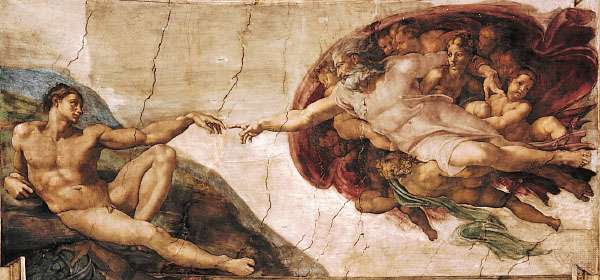
Part of the ceiling of the Sistine Chapel in Rome. Painted by Michelangelo between 1508-1512. Nine scenes from the Book of Genesis tell the creation myth of Catholics at that time. This particular scene is known as the Creation of Adam.
Every society has at least one communal explanation as to how the world began, people came to be, and their relationships with some pantheon of transcendental entities. We call these explanations Creation Myths or Genesis Stories, the latter from the religious literature what the Christians call Genesis, which is also the first Book of Moses (Chs. 1-10) for Jewish people. In that traditional belief system, “the earth was waste and void; and darkness was upon the face of the deep” or something along those lines depending on which version of a Judeo-Christian edited script to you refer. Nonetheless, the point is that is the understanding of many raised in a Judaic-Christian tradition; those raised or at least living in this country would have been at some point in their lives would be familiar with the nothingness aspect of their Creation myth in two of the Big Three.
Along the lines of what some of my students may be familiar with, an Apache Creation myth begins with nothingness. According to Jim Heitmeyer “In the beginning, nothing existed–no earth, no sky, no sun, no moon, only darkness was everywhere. Suddenly from the darkness emerged a thin disc, one side yellow and, the other side white, appearing suspended in midair. Within the disc sat a small bearded man, Creator, the One Who Lives Above. As if waking from a long nap, he rubbed his eyes and face with both hands.”[1]
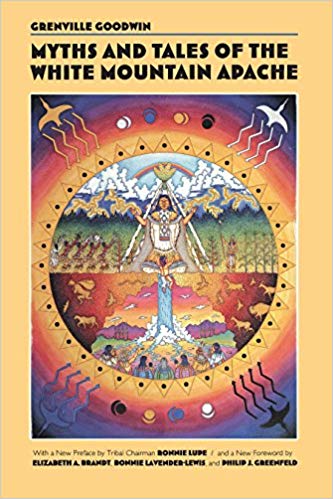
A Sioux Creation myth involved a great flood because the Creating Power believed the people needed to be punished. Sound familiar? Nearly every civilization I have studied includes a flood myth (and a hero who saved his family and all of the animals, bugs, and other critters): “There was a world before this world, but the people in it did not know how to behave themselves or how to act human. The Creating Power was not pleased with that earlier world. He said to himself: “I will make a new world.” He had the pipe bag and the chief pipe, which he put on the pipe rack that he had made in the sacred manner. He took four dry buffalo chips, placed three of them under the three sticks, and saved the fourth one to light the pipe. The Creating Power said to himself:“ I will sing three songs, which will bring a heavy rain. Then I’ll sing a fourth song and stamp four times on the earth, and the earth will crack wide open. Water will come out of the cracks and cover the land.” When he sang the first song, it started to rain. When he sang the second, it poured. When he sang the third, the rain-swollen rivers overflowed their beds. But when he sang the fourth song and stamped on the earth, it split open in many places like a shattered gourd, and water flowed from the cracks until it covered everything.”[2]
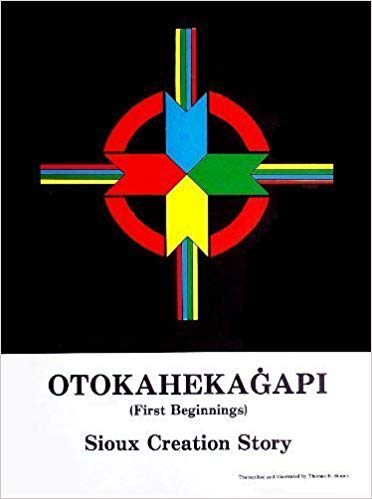
A Navajo Creation myth was migration-based, more in reality with how this hemisphere became populated. But in this Navajo story, different kinds of people went from World to World. “The Fourth World. The people game into the fourth world before the sun and moon were created. They were on an island with high cliffs in the middle of a bubbling lake. With help from the Wind God, people were able to leave the island. First Man and First Woman built the first hogan to live in.” [3]
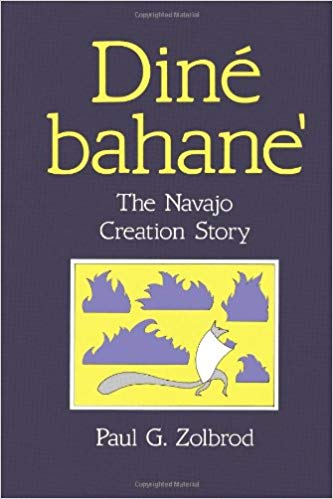
Creation myths explain how people arrived or came into being. And if you read carefully, you can find out why people arrived or came into being. How is mechanical. How did you come to school today? I pulled out of my driveway and I headed towards Space Center Boulevard, where I turned left. 2.5 miles later I merged into the Gulf Freeway heading north . . . How is exact, but sometimes predictable. Why, however, is emotional, individualistic, or goes to the state of mind. Why did the Hopi, Arapaho, Sammamish, Iroquois, or Ute come into existence? There may be five different reasons based on their five different primary deities. Why did you come to school today? That answer could change from day to day based on a series of events and emotional responses that are connected or unconnected in different ways each day. And, ten students could have ten different ways of answering the questions. The “why” question is an interesting question, at least to me
Why did the American War for Independence happen when it did? In other words, what chain of events happened in what specific order that resulted in the Universe aligning in a particular way that Thomas Paine wrote Common Sense, George III sent in Hessian troops, and Jefferson, et al., wrote the Declaration of Independence in close proximity to one another?
Why do we use the phrase “the sun setting” or “the sun rising” when we know the Earth revolves around the sun and thus we know the sun neither rises nor sets?
History is the culmination of the words and deeds of individual people who narrate the “what” that historians use to explain the “why.”
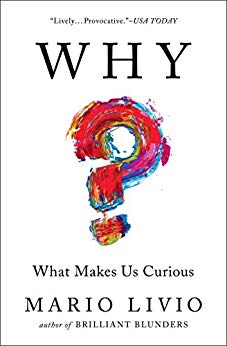
Once upon a time . . .
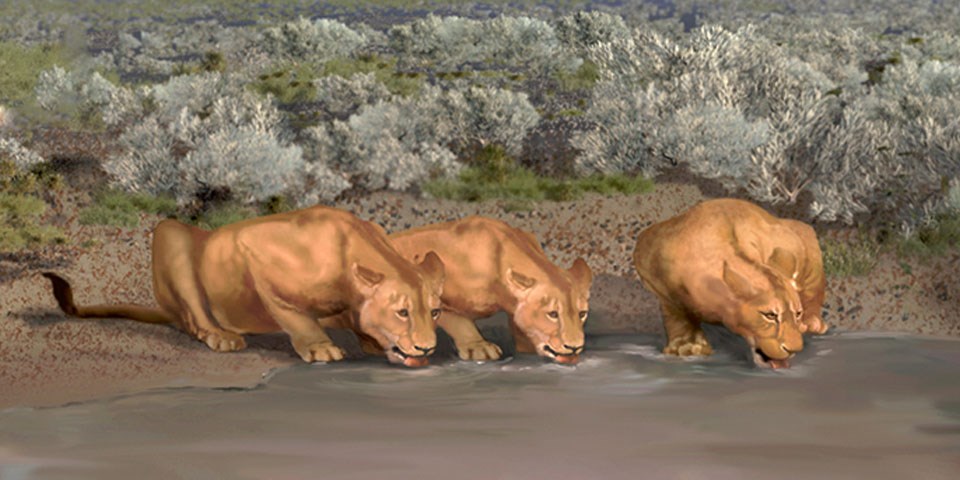
Human beings (Homo Sapiens) are relatively new to this part of the world. For the majority of its existence, just animals and plants from little fluffy bunnies to behemoth mastodons, giant sloths, American cheetah, saber-toothed cats, wolves, two members of the camel family, and bison, to name a few during the Pleistocene Age (2.5 million to 11,700 years ago). People were not indigenous to the Western Hemisphere, well, at least we have no evidence that people were indigenous to the Western Hemisphere. Rather, some believe that people migrated from Asia to what is today Alaska and Canada around 40,000 to 50,000 years ago.[4]
Other archeological evidence (burned bones) suggested that people had settled in North America around 35,000 years ago. But in 2017 the date of 25,000 seems more likely.[5]
The big lesson you need to understand in this chapter is that there existed some very old and established cultures long, long before the Europeans arrived because one outdated myth was that North America was an empty vessel and Europeans turned North America into a venerable Garden of Eden.
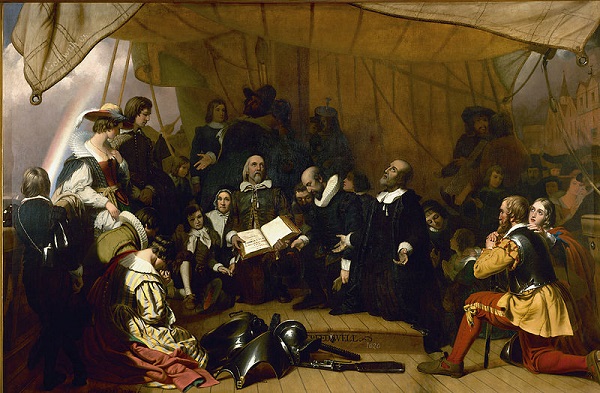
Embarkation of the Pilgrims, oil painting by Robert W. Weir, circa 1844[6]
For the Europeans in general, and the English in particular, there was a right way of doing things and a wrong way of doing this. The right way was the European (English) way and the wrong way was the Indian way, and thus European colonists, and in our case, we are talking particularly about English colonists, justified their taking of indigenous peoples’ land, trying to use them as slaves, killing them to remove them to quicken the pace of the western march of civilization, destroying Indian culture of those who remained through such formal practices as the Americanization movement. The English (and after 1776 the Americans) will do these things to the indigenous peoples seeing them as the antithesis of what it meant to be English (American) and thus interfering with God’s plans for the land and for Americans, religion will play a major role in US history at least through the end of Reconstruction.
“Showing up is 80% of life.” -Woody Allen
Immigrants came here over land and by boat (up the Pacific, hugged the West Cast, and embarked accordingly). Initially, they were hunters and gathers -they got their caloric intake through hunting animals and by collecting naturally-growing roots, tubers, and berries.
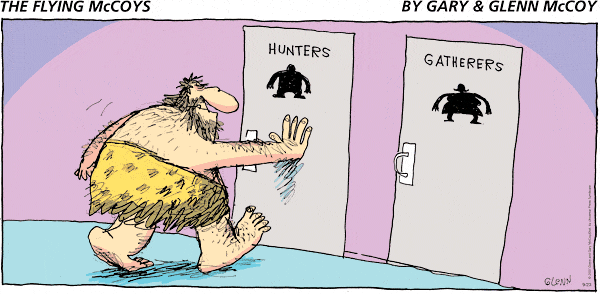
This cartoon illustrates the prehistoric sexual division of labor.
Eventually, Native American women will farm, British men will farm. Farming enhanced your manliness. Native American men hunted for sustenance. In British society, only poor people hunted for food. British colonists therefore would look down upon Native cultural adaptations as well as them as a people. Someone to remove from their need to advance God’s plan.
Hunting and gathering is not the best way to ensure your caloric intake. First, hunting and gathering is very time and caloric-intensive, second, relying on nature is sometimes problematic. What do you do in the winter? What if there is a drought? What if a pestilence destroys the wild-growing plants? Thus, we believe that shortly after arriving to North America, Amerindians (the descendants of the original waves of Asiatic immigrants) settled down and thus embraced agriculture.
There are four interconnected results to the development of agriculture. First, life becomes more stable as people are less reliant on hunting and gathering for their caloric intake. Stability means the establishment and growth of society: towns, cities, large urban centers, Second, agriculture is a more reliable and diverse food source than trying to locate and gather a sufficient amount of edible materials. Third, people became more healthy with a reliable diet.
An interesting aside (or may be interesting only to me) is that in many of the Amerindian communities, archaeologists have discovered walls surrounding the permanent buildings. Now, there are two reasons for walls: 1) to protect the people inside from the nasty stuff outside; or, 2) to keep people in; to keep them from leaving. Nevertheless, the growth of communities meant the creation of permanent structures, normally built near freshwater sources, and they built canals (for irrigation), dikes, and roads. These work projects tend to imply that there also existed some form of government. A body that makes decisions as to where to build the canals or where to put the roads. Unfortunately, nearly all Amerindian societies embraced an oral tradition of passing down laws, culture, and history and thus you will not come across any diaries, papers, or documents that fully tell the story of Amerindian life.
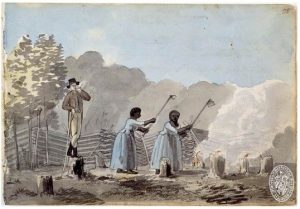
“Those who labor in the earth are the chosen people of God.” -T. Jefferson[7]
People settled down in ecologically diverse regions such as being surrounded by a lake in what is today the center of Mexico City, or in the desert such as the Anasazi of the Four Corner area of what became the American Southwest, or the woodlands of what became New England. Ecology tended to present challenges to farming. For example, Aztecs settled down on an island, surrounded by a huge lake, in what is today Mexico City. Land on an island is extremely limited and so with a growing population, the Aztecs needed to invent a new way of farming, hence the chinampas[8] or bog-farming. Aztecs would create floating patches of land (bogs) near the shores of the lake that surrounded their island. Over time the bogs fanned out, eventually filling in the lake with usable farmland. Likewise, the Anasazi people lived in a desert so they faced particular challenges to farming. There are very few places in a desert where water comes to the surface, and those places are called oases. An oasis is, simply put, a place in the desert where the water table comes to the surface of the land. Now, an oasis is a relatively small chunk of land, just like the bog farmers of central Mexico, thus the crops they grew had to be carefully selected for their caloric punch, ease of growth, and ease of storage. Finally, Indians such as the Seneca in what became New England also had to deal with ecological issues. For example, trees. Lots of trees. The Seneca lived in the woodlands. Thus in order to farm, they had to remove trees, but they did so in a time before electric saws. They did not even have iron tools nor oxen to assist them. The result was the creation of small patches of land capable of farming. Interestingly enough, the Aztecs, Anasazi, and Seneca farmed similar crops.
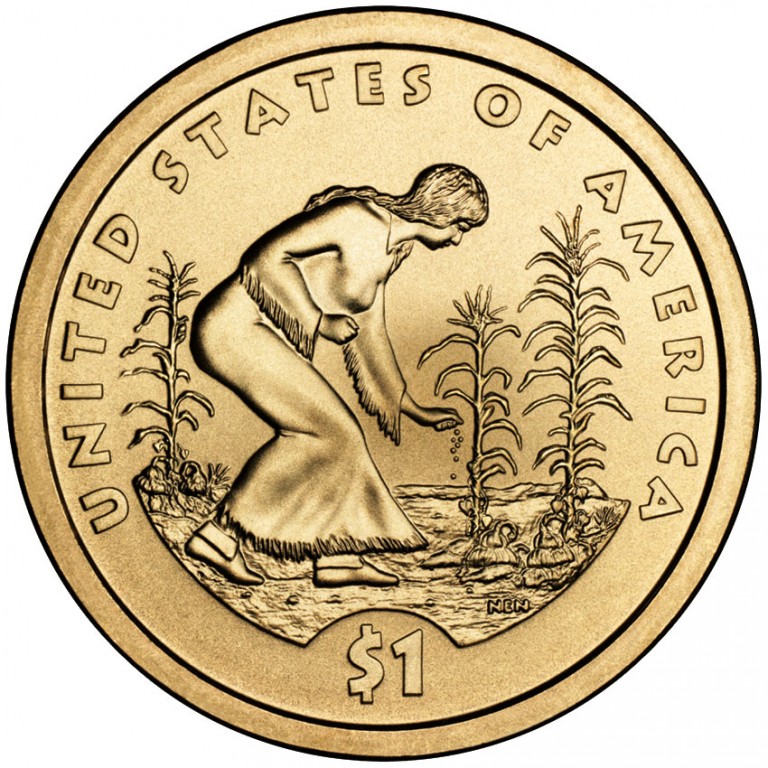
From the US Mint website: “Maize was domesticated in central Mexico and spread from the southwest through North America, along with symbiotic “Three Sisters” agriculture, in which corn, beans and squash growing in the same mound enhanced the productivity of each plant. Native American skills in agriculture provided the margin of survival for the early European colonists, either through trade or direct sharing of expertise, and agricultural products native to the Americas quickly became staples throughout Europe.
Three Sisters symbiotic agriculture—planting corn, climbing beans, and squash together in the same plot—also originated in central Mexico and probably spread simultaneously with the corn. In this efficient planting method, corn stalks provided support for the bean vines, which added nitrogen to the soil. Squash provided ground cover, which discouraged weeds. Productivity was much higher (by some estimates as much as 30 percent) for the three grown together than each grown separately.”[9]
Wherever you go in Pre-Colombian America, you tend to discover that Indians grew the same holy trinity of crops: Corn, Beans, and Squash, known as the Three Sisters. They grew corn because of the caloric value. Corn is full of sugars (carbs) and can easily be ground into flour, baked, boiled, or mashed. Corn tended to be the basis of Indian cooking. Now for those of you who are not farmers, or have not visited Iowa, corn grows erect. Straight up, however, its roots are very shallow and can easily be baked by an unrelenting hot summer sun. Indians also planted squash to shield the corn’s roots. You see, squash (from Acorn squash to zucchini) tends to grow low and close to the ground and all squash have large, umbrellic leaves that if planted around corn, could act as a shield to the rays of the sun. Finally, also keeping in mind Indians’ need to grow crops in a very patch of land, Indians would grow beans. Now beans grow up and out, however, in order to produce the bean, the plant must climb off the ground and so in their pursuit of saving spaces, Indians planted beans right next to corn so that the bean plant would use the corn plant as its trellis.
Mesoamerican Indians (South)
OLMECS:
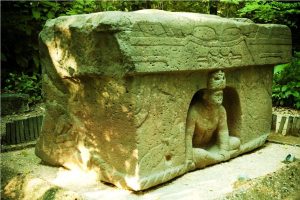
Olmec Carving Altar 4, La Venta, Tabasco, Mexico
Again, so many of the pre-Contact societies had an oral tradition. They did not stuff down, or so we thought. Not their history. Their culture. Why they did what they did. So, our evidence is limited two sources: artifacts and oral traditions passed along to the Spanish (who wrote them down). This textbook is not intended to be used for my Mexican-American history, Mexican-American Studies, or my Minorities in the US class, so so this is going to be cursory, at best. Lo siento!
One of the oldest, organized peoples in what is today Mexico were the Olmecs. We believe that Olmecs had a government, believed in many gods (pantheism), and held elaborate religious ceremonies through the oral traditions passed down for hundreds of years, then Olmec history was passed down through other groups until the Spanish finally wrote them down. In other words, how accurate are stories that have been passed along orally for say 500 years before someone first wrote them down? And so with that in mind, it’s time for my Fascinating Fact of the Day.
Other oral traditions took much longer to become finalized (Tanakh) while others (New Testament) only took about 400 years before a meeting of religious and secular leaders decided on what was to be included and what was non-canonical. The oldest story that appears in the Torah is the flood myth. The flood myth was known in Mesopotamia through the epics of Gilgamesh. Flood myths are widespread among world civilizations, including many indigenous groups found in the United States today. According to the historian Roger C. Echo-Hawk, “In many Indian traditions, a great flood covered the earth in ancient times, and some stories associate this event with the end of the age of monsters. Traditions of a mighty deluge can be found in oral and written literatures from around the world. The end of the most recent Ice Age, some 12,000 years ago, could have involved cataclysmic flooding.”[10] To reject all other religious literature simply on a belief in Truth is the base of any religion. Religion will play various roles in US history.
Recently, we discovered that the Olmecs did indeed develop a form of writing, about 500 years before who we believed to have been the first to develop writing: the Zapotec. “Dubbed Stela 1 of La Mojarra, this monument was inscribed with 465 glyphs arranged in 21 columns, and the image of a ruler. The writing on it is nothing like any other writing system in Mesoamerica, such as Maya, Zapotec, Mixtec, or Aztec.” Translated words include animals jaguar and turtle), parts of the body (penis), celestial bodies (sun and earth), titles of rulers (lord, priest, king), and words that could be used in sacrificial ceremonies (sacrifice, sprinkle, offering, and to sing). Go to Lawrence Lo’s website ancientscripts.com. However, the author of the website is a software engineer, not a linguist or an archaeologist. He has collected information on ancient writing available on the internet.[11]
Source: https://en.wikipedia.org/wiki/Olmec_colossal_heads#/media/File:La_Venta_Monument_4.JPG
The Olmecs another type of record behind giant heads. They carved giant heads out of basalt. Between 4 and 11 feet tall, weighing several tons, and dated to at least 900 BCE. The 17 stones were brought to the sites from the Sierra de los Tuxtlas mountains of Veracruz. In other words, carving these heads was a purposeful act. Thus there must have been meaning in Olmec society for these heads. There are two parts of the carved heads -the face and the headgear. The traditional explanation is that the heads were carved in honor of Olmec leaders. But when I look a the face, I see the likeness of newborn babies because the face is flat, the nose is wide and broad, the lips are engorged, and the eyes are protruding. These features are present in newborns who experienced vaginal births. So my theory, based solely on the belief that I am looking at the facial features of newborns, is that the heads were carved to honor babies. But, you would not carve a ten-foot-tall head for every baby born, which leads me to point out the headgear. There is something on the heads resembling a half-helmet for a motorcyclist or an old NFL leather helmet. But the headgear has ear flaps. And, the headgear is ornate with carvings, thus suggesting that the wearer was special, which has led me to conclude that maybe the heads were carved in respect for the babies of powerful men who died in childbirth. However, more than likely the heads are of religious and or government leaders.
MAYAS.
Again, the Mayas did not leave a written record, as we know it. They left behind a calendar and hieroglyphics. They also left behind their oral tradition passed down from the Olmecs to the Aztecs, and then intercepted by the Spanish in the early sixteenth century. What we know about the Mayans is that they developed very elaborate social and political systems, with numerous religious and temporal leaders, daily observances, and they were dependent on controlling the cacao trade out of present-day Guatemala. They also developed huge cities, around half a million people which rivaled anything in Europe at that time. One interesting fact about these people was that they had a teeth fetish. Long before rappers such as Chamillionaire sported gold and silver throughout their teeth, the Mayans were drilling holes in teeth and inserting precious and semi-precious stones. They would also carve the teeth. We believe the focus on the teeth had something to do with Mayan status in society.
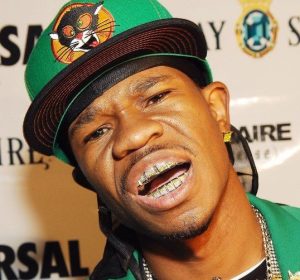
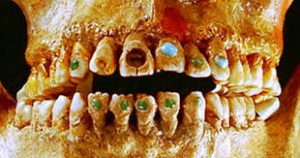
AZTECS:
The Aztecs were not indigenous to Mexico. Rather they migrated there from the American Southwest in the early twelfth century. They fought their way to what is today Mexico City, establishing an elaborate system of bog-farming. They were brutal and demanded tribute (in both riches and people) for their daily human sacrifices. The Aztecs expanded on the collection of old Mayan deities and most of the Aztec gods demanded daily tribute, usually in the form of a human sacrifice. For example, Aztecs believed that the god who brought the sun up each morning demanded the sacrifice of 100 virgins, daily. So they did. And you know what? The sun always rose after the sacrifices! Finally, the Aztecs developed a ball game. Played in huge courts, the object of the game was for one player to kick or knock a ball through a hoop ten feet off the ground without using their hands. Games would last for days. Sometimes the winners would be sacrificed to the gods. Sometimes the losers were sacrificed. And sometimes everyone would be sacrificed. One reason why the Spanish were able to so quickly conquer Mexico was that the Aztecs terrorized every other tribe and thus the other tribes threw their lot in with the Spanish. Disease was another reason why the Spanish so quickly conquered Mexico. I’ll save that story for the next chapter.
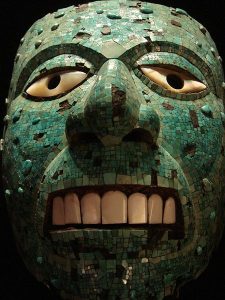
Mesoamerican Indians (North)
Iroquois
In what became the United States, there lived hundreds of thousands of people from dozens upon dozens of tribes or affiliations. They spoke different languages. They developed different cultural strategies, however, they tended to be tied together by trade and thus what we will look at below are some of the shared characteristics of Indians who lived in North America. Again, nearly none of these Indians embraced the written record, thus what we know about them tends to be handed down orally over time. From Indian to Indian. From Indians to Europeans. And from Europeans to historians. And of course today with the internet, nearly all of these Indians I am going to talk about maintaining their own web presence. One of the more less-understood cultures was the Mississippian Society.
These Indians lived along the banks of the Mississippi and their main characters were the mounds they built and left behind, thus they are also known as the mound-builders. Most of the mounds are just that-mounds. A few were built in the likeness of animals, such as a snake when viewed from the air. Something similar to the Nazca lines of Peru. Let’s turn to the four corners of what became the United States and examine some of the Indian groups that we will be touching upon throughout this whole class. From the Northeast, we have the Iroquois. From the Southeast, we have the Cherokee. From the Southwest, there’s the Pueblo Indians, and from the Pacific Northwest, the Chinook Indians. First the Iroquois. The Iroquois were not an Indian per se, but rather a political organization made up of several tribes from the Northeast: Seneca, Onondaga, Oneida, Tuscarora, Cayuga, and the Mohawk. These six tribes lived in a densely populated region. Why do people go to war? Over resources is the answer. And thus these six tribes were frequently at war with each other over access to resources. Now sometime in late March or early April of 1450, an Indian named Hiawatha approached the chiefs of the six nations and told them that he wanted to create a confederation of the six tribes in order to end the fighting. Hiawatha was rebuked. So Hiawatha told them that he was so powerful he could blot out the sun and unless they created this confederation with Hiawatha in charge, he would blot out the sun. The other leaders ignored him so Hiawatha blotted out the sun sometime in late March or early April of 1450. Now, the Indians of the Northeast did not use the Julian calendar so they would have no knowledge of such devices as “March” or the year “1450.” Yet historians believe that Hiawatha talked about creating this confederacy in late March or early April of 1450. So how do we know that? We know that because sometime in late March or early April in 1450 there was a solar eclipse that would have been seen throughout the Northeast. In this case, myth and science meet. By the way, after the sun came back the other leaders decided to form the Iroquois Confederacy and made Hiawatha their leader. The Iroquois was a farming people and farming was a woman’s job. The most important or powerful women in the Iroquois community farmed corn. The head of the corn farmers also selected their tribes’ representatives on the Iroquois council and they instructed the male representative how they will vote on council matters. In other words, Iroquois women were powerful, certainly more powerful than their European counterparts.

Iroquois Women[12]
The Iroquois, also known as the Haudenosaunee, were stationed in what is now northern New York and southern Quebec and Ontario. The Iroquois originally had five nations: Mohawks, Oneidas, Onondagas, Cayuga, and Seneca. The sixth nation, Tuscarora, later joined in the seventeenth century.
The Iroquois were different from European culture. Europeans thought the Iroquois had “petticoat governments” due to roles that women had; which included participating in farming. Women would be the head of the household; they were also owners of land and would be responsible for the children and the clan. Due to this, anthropologists referred to Iroquois societies as “separate but equal spheres of influence”. The roles of women were just as important as of the ones from the men, they provided for all. The women provided for their longhouses, their own families, and the whole community.[13]

One of the vast differences was the Iroquois had from Europeans was a matriarchy. In a matriarchy, females are equally as important as males, or even more than them. In some cases, women would hold a high political position and be chiefs. Women ran longhouses, which were where they lived. Each longhouse fit about twenty families. The clan mothers, the eldest mothers of each family, made important decisions such as choosing chiefs or even remove them when the clan mothers felt as if the chief did not meet their expectations in leading. The Iroquois also had women’s councils; they were considered more powerful than the men’s councils since the women would overturn the decisions of the men. It was up to the women’s council to decide to go to war or not. It is said that because of the women, peace was kept within them since they were the ones who decided if it was worthy or not to go into war with other tribes.[14]
All five nations of the Iroquois were matrilineal, once a child was born, they are members of the mother’s clan or kin group which was either: the bear, wolf, deer, hawk, snipe, heron, turtle, beaver or eel clan, the only thing they gained from their father was their last names. Children, especially daughters, inherited everything including resources and their status from their mothers. Sons would just inherit tools and materials used for hunting from their mother’s father or their older brothers. [15]
When a couple was going to marry, the whole ceremony was arranged by the woman’s mother and the man’s mother. The woman getting married, would not be affected. Her last name would remain the same. The man would be the one who would be affected, he would have to join the clan of his wife. The oldest women were responsible for keeping the relationship going, especially the mothers of the spouses.[16]
The Iroquois women were responsible for the food they grew, since they were horticultural, meaning they focus on fruit, vegetables, and materials. They would also search for wild berries, fish, and even hunt. The men were mainly in charge of the meat and fish whilst the women provided vegetables. The most important crops to the Iroquois where the three sisters: winter squash, maize, and climbing beans, they were important because it was used to gather the community together and helped their economy by trading.[17]

And as Ashley Diaz pointed out in her research, women’s agricultural ways extended beyond consumption. “The corn harvest women oversaw how calories were distributed among the people, especially those who hunted, which were the men. This illustrates how powerful their position is in farming since the women get to decide who eats what and how much they get to eat. Not only was corn used for calories but also as a resource to make tools like a scrubbing brush and ropes.[18] However, food wasn’t the only thing women had control of in their tribe, they also had another major role when it came to their Tribal Council and electing their sachems.[19] Even though the speakers on the council were men, the women had the right to judge and elect those who would become speakers in the first place within their tribe.[20] If their perspectives weren’t as close to what the women believed, the men would either be replaced by someone new with similar beliefs or the women would refuse to feed them. Allowing women to have this kind of power really demonstrated how in charge and superior women were compared to the men in their tribe. This enhanced their leadership skills because women were responsible for making sure men did their part when it came to the tribe. This political authority women had within their tribe not only conveyed their hierarchy but the dominance over men because women had the say when it came to Iroquois’s people.”[21]
When worshipping, the Iroquois believed in a goddess referred to as The Sky Woman and how Earth came to be because of her. The Sky Woman birthed twins, the good and bad spirit, the bad spirit gained his name through causing his mother’s death. The good spirit became the sun and stars while the bad spirit contradicted everything the good spirit did. When performing rituals, women participated in religious activities, such as the Sun Dance and harvesting crops for the upcoming year. The rituals were done as a way to give thanks to the Earth for providing a successful year.[22]
Cherokee
An example of a First People who lived in what became the Southeast portion of the United States are the Cherokee and one of the Cherokee war leaders was a man named Dragging Canoe who fought on the side of the British during the American Revolution. Now, most civilizations are patrilineal descendants. What’s your last name? Where did you get it from? Your dad? I am not shocked. Most civilizations get their last names from their father -that’s called patrilineal descendants. The Cherokee, however, were matrilineal descendant. In other words, they got their names from their mothers. Women were powerful in Cherokee society. When a man and a woman got married, the man packed his belongings and moved into his wife’s house. Actually, the house belonged to her mother. So, gentlemen, your mother-in-law would rule the Cherokee household and when she died, the eldest daughter took over. Cherokee had a type of divorce, however, only women could initiate the proceedings. Or, as one historian wrote, “Cherokee Women of the eighteenth century were largely responsible for the organizational continuity of the village in which they lived, while men moved among them, propelled by marriage.”[23]
Cherokee women could operate in both spheres, taking up for their husbands such was the case of Nanye’hi. Her husband died in battle against Muscogee Creek. She literally picked up his weapon and rallied the troops to what became a decisive victory, earning her the title “war woman.”[24] Cherokee women also seemed to have reproductive rights to include “having the right to practice abortion and infanticide.”[25]
According to Keyli Cartajena[26], in the Cherokee society, both genders were equal and were able to participate in the same activities. “Women even engaged in resource-getting activities such as foraging for wild edibles, fishing, farming, and even hunting.”[27] They farmed vegetables such as corn, squash, and beans. They also hunted animals such as rabbits, deers, turkeys, and even bears. Men principally accepted the jobs of hunters, while ladies assumed liability for agriculture and social affair.
The women also had a voice in the council and they decided who would go to war and who would not. Women occasionally even fought in battles beside the men and were called War Women, and the people respected and honored them for their bravery.
Being in a matrilineal kinship society meant that if a Cherokee man married a Cherokee woman, they would move into the woman’s house, which is his mother-in-law’s house. If a Cherokee couple had a baby, the newborn would take the mother’s last name, not the father’s. With this kinship, it may even be that the Cherokee “practiced polyandry.”[28] Polyandry might’ve been due to the high status of both women and men. This meant that both genders could have sexual freedom and could achieve an easy divorce without any subsequential consequences. The women could easily kick the man out of the house and there would not be a single conflict. What would the man have to do? You guessed it. He would have to move back in with his mother.
Anthropologists have labeled the Cherokees as matriarchies. A matriarchy is a society governed by a woman or women. Having matrilineal descent does not make a society a matriarchy. “Societies such as the Iroquois, Cherokees, Navajo, and many others are not governed by women; they are governed by women and men.”[29] Each gender had its roles in the society, each was valued and needed for the survival of the society. The wealth and status of a family depend on the contributions of both women and men.
The ladies in Cherokee society had indistinguishable rights from men. Before the appearance of the white man, ladies had a significant job in the family life, economy, and administration of the Cherokee. At the point when the Europeans visited these towns in the mid-1700s, they were astonished by the rights and benefits of Cherokee women.
They were astonished because like I said this was an uncommon way of living. Most tribes at the time had a patrilineal descent versus a matrilineal descent. The Europeans were disgusted by this way of living and thought the Cherokee were inferior and very poor only because it was not the “ English way.”
I wonder what happened to the role of Cherokee women after their forced migration to what today we call Oklahoma in the early nineteenth century? Did the “Trail of Tears” affect gender relations in Cherokee society? In other words, did Cherokee women lose power (which is my guess) as a result of that cataclysmic event?

Pueblo
An example of a First People that resided in the American southwest is the Pueblo, named by the Spanish because of their dwellings. Women had the power of life and death over men in Pueblo society. They believed that all a woman has to do was to think bad thoughts about a man and then he would die. The good news, gentlemen, is that not every woman in Pueblo society can kill you merely by thinking about you. In fact, when you’re born no woman can kill you, you will give that power to women. Now folks, what do you think a guy would want or want to do in exchange for granting the power of death over to a woman? Think hard. The answer is sex. The Pueblos believed that every time you had sex with a woman, you gave that woman the power to kill you. So, this was probably s strategy developed to ensure monogamy. I mean, if you grew up in a society that believed that every woman you had sex with could potentially kill you just by thinking about you, you would probably limit your sexual partners to say, just one! In fact, when the Spanish invaded, it was not the Pueblo warriors who first attacked, but rather Pueblo women. Pueblo women threw themselves at the Spanish soldiers, hoping that after having sex with them they would be able to kill them. But it did not work. “When Jesus came, the Corn Mother went away,” became a Pueblo saying after the fifteenth century. By the way, the Corn other was the Pueblo Indians’ chief deity, chief protector, and provider.

Chinook
Next, we go to the Pacific Northwest. Living in the Pacific Northwest was something akin to living in a grocery store. There was an overabundance of berries, farmland, fish, and game. There were so many resources that the people of the Pacific Northwest had no need to fight over the resources. With a lot of extra time (and money) on their hands, Indians of the Pacific Northwest, such as the Chinook developed artwork. For example, they build and decorated totem poles. Chinook women made highly decorated (with beads) clothing and blankets, such as the work in the attached photo of a Chinook woman named Te-Mow-E-Ne. Indian women, because they were not supporting their men in combat, had time to develop arts and crafts. In fact, Indians of the Pacific Northwest developed a kind of an anti-war strategy they called the Potlatch. Potlatch was a week-long festival. A meeting of Indians from Alaska to California on the banks of the Puget Sound, near the city of what we call today Seattle. Indians would come from far and wide with their excess building supplies, food, canoes, fishing equipment, clothes, et cetera, and trade with the other Indians. They also traded family members. For example, you live in Alaska and your child complains to you that if she sees one more snowflake her head will explode. So at the next Potlatch, you send her with an Indian family from California, and over the next year your daughter is taught about the language and customs of her newly adopted family. Then they bring her back to the next Potlatch where she shares all of her newly found knowledge with her original family. Potlatch continues today in Seattle, although today Potlatch is more of a celebration of Indian culture, although you can still get your fill of smoked salmon.
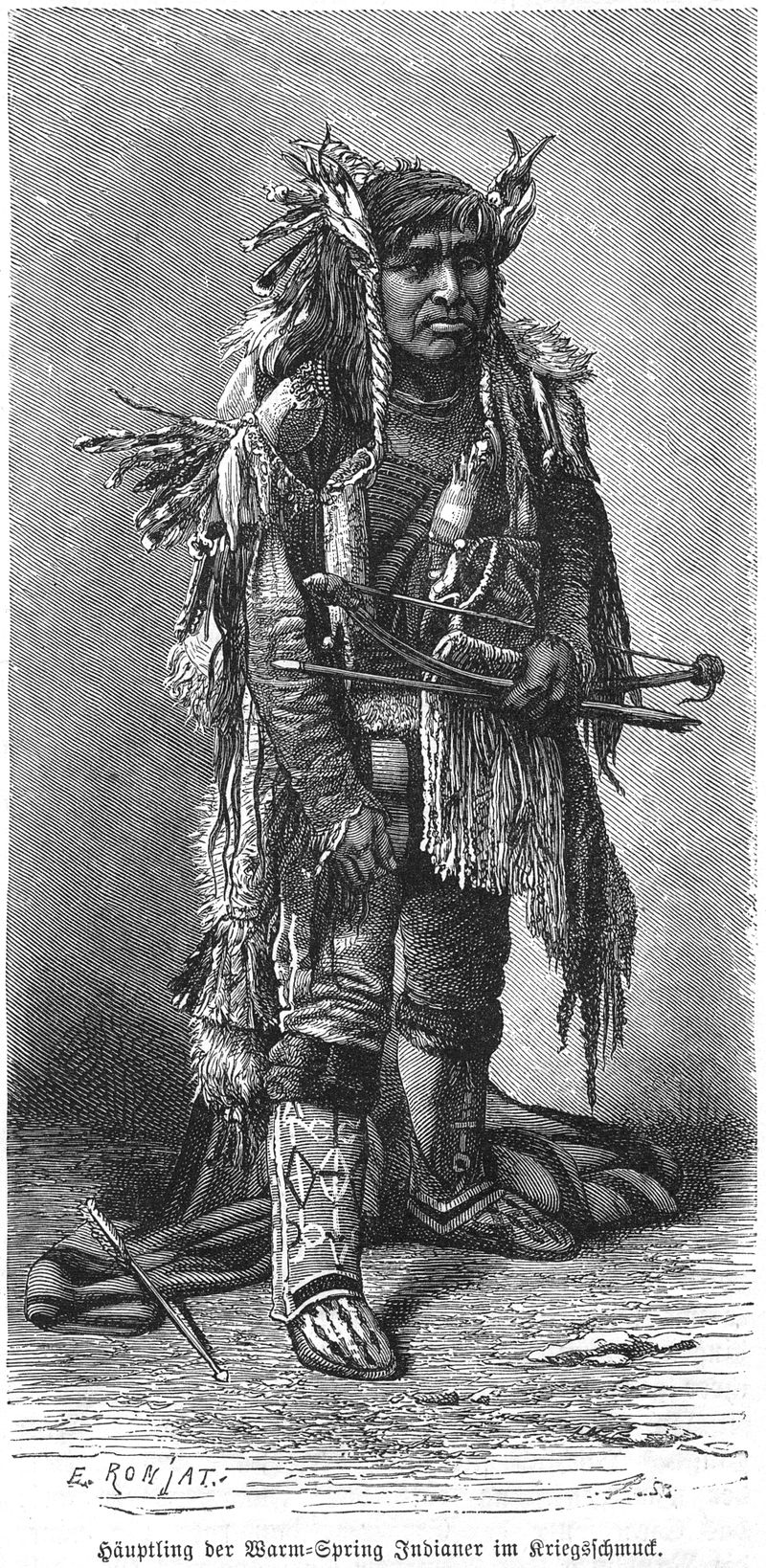
Andrea Robelo, Christian Sarmiento, Ketucua Terell, and Jarren Wright looked into the Chinook language:
Chinook Jargon was a pidgin language belonging to the Penutian Language Family that was mostly based on Chinookan.[30] It contains parts of other nearby native languages such as Nootka and eventually European languages such as English and French.[31] Chinook Jargon started long before contact with the Europeans; however, its beginnings are linked to the trade between the Chinook and Nootka peoples.[32] Its use helped facilitate the shell money economy shared by natives of the area.[33] It originated between the Puget Sound and southward following the Columbia River. The first record of the language being spoken with trappers and traders in the area occurred in 1785.[34] It was picked up and further changed once encountered by the European and Chinese, however, it was not until 1811 when the city of Astoria was founded that it became a major factor and began to be used all through the Columbia River Basin and eventually to the southern part of Alaska.[35] The height of the Chinook Jargon was the 1870’s where some estimations have said that it was used by over a hundred thousand people on a daily basis.
Chinook Jargon became so widespread that it became the Lingua Franca or in other words the unifying language of the area.[36] At one point it was quite common for settlers and immigrants moving to the Pacific Northwest to be equipped with one of the many printed dictionaries of Chinook Jargon. All the languages spoken by both the settlers (Europeans and Chinese) and the Natives of the area made the Pacific Northwest a very diverse location linguistically. Interestingly the actual number of words used in Chinook Jargon was quite small at 500 words, with a good amount of those being onomatopoeias (a word based on the sound of the object trying to be described).[37] The sound of Chinook Jargon has been described as guttural and a bit harsh with many of the sounds being made by pushing the tongue upwards towards the hard palate. Words originating from the French speakers of the area were often changed because the Natives found the more nasal sounds characteristic of French hard to reproduce.[38] All these idiosyncrasies lead to many variations in the written form of the language as many found it hard to write some of the clicking sounds used in the language phonetically. After its height of use in the 1870s Chinook Jargon began to decline slowly as the Native population began to speak English more frequently but there are some reports as late as 1921 of older settlers and Native Americans still using the language at reunions and picnics.[39] While Chinook Jargon is not spoken widely anymore it most assuredly changed the progression of both Native and settler communities in the Pacific Northwest and made a major impact as it bridged the language gap between Natives and the settlers who colonized them.
Texas
I have been living in Houston for about one month before Tropical Storm Allison hit. I’ve heard all sorts of stories of the types and kinds of indigenous peoples who lived in what is today Seabrook, Kemah, and Clear Lake. Like stuff on the internet, I take these stories with a truckload of salt. According to Stephen Harrigan, during the Fall and winter months, the Karankawa people populated the central coastal region of what became Texas. They caught a variety of fish with nets and bows. They were “famously tall,” sported tattoos, used “alligator grease to ward off mosquitoes” and sometimes pierced their lower lips.[40] Like other hunter-gatherers, they followed the food sources and thus were seasonally driven. In the warmer months, they live in the mainland prairies. The Karankawa made pottery painted with tar and lived in the light, willow cane huts that could be quickly torn down and easily carried from camp to camp. And, according to Harrigan, the Karankawa were the first First Peoples to meet Europeans in Texas.[41] But that’s a story for the next chapter, researched and written quite well by one of my students.

Kickapoo[42]
In the northeastern part of the continent near the Great Lakes resided a Native American tribe known as the Kickapoo, whose daily life and entire existence revolved around religious ceremonial traditions. Their religious ceremonies were never written down but instead were passed orally through the generations. These traditions united the Kickapoo people with a common bond of beliefs, customs, and laws.

Historians cannot give an exact ancestry of the Kickapoo tribe except through tribal folklore and knowledge of their language. They spoke a language called Algonquin which was common in Northwestern Ohio and Southern Michigan between Lake Michigan and Lake Erie. Some legends say they used to be a part of the Shawnee people but split apart due to a bear paw argument.[43] In spite of this uncertainty about the origins of the Kickapoo, their history and ceremonies distinguish them from other Native Americans.
The Kickapoo people were animistic which means they believed everything has some exclusive spirit, from trees and animals on this earth, to weather and the elements all around us. The majority of their traditions revolved around their religious ceremonies. Their beliefs could be found in everything from their “sacred bundles” to their laws and even their traditional housing structures. The Kickapoo people believed in a supreme god named Kisiihat, who lived in the sky. Kisiihat created the world and had many spirits who served as his messengers. The spirits were believed to be tobacco, fire, the sky, and the four winds. These messengers would carry messages from Kisiihat to the Kickapoo people and back to Kisiihat.[44] Kisiihat had a son named Wisaaka who created the Indian world. He came down to earth to teach the Kickapoo life skills such as hunting and how to build their homes. For this reason, everything was sacred and required a ceremony.
The Kickapoo tribe started each year with a ceremony to restart the cycle of ceremonies. This New Year celebration was dedicated to give thanks to their god and ask for his blessings. The year started whenever lightning could be observed in all four cardinal directions.[45] Their interpretation of cardinal directions and time was created by observing the passing seasons and the movement of the sun.[46] The New Year ceremony was a clan festival. Each family group, or “clan,” would bring their sacred clan bundle and perform a ritual ceremony conducted by the bundle’s owner. The bundles were not alike and contained items with special meanings to signify each of the different clans. During the bundle ceremony, the bundles would be passed through the smoke of the fire, which was considered a pathway to Kisiihat, and then the people would thank Kisiihat for his blessings. The keepers of these sacred bundles were women, but it was the men’s responsibility to learn the ritual, which sometimes took years.[47]
Since Wisaaka taught the people how to build their homes, the building of a home required a special ceremonial process. These homes were called Wiikiaapi or wikiups, and one could not be built until a woman had gotten permission from the chief. The details are not known, but once permission was granted for the building of the wiikiaapi, the Kickapoo performed a home-building ceremony. The ceremony would include music, dancing, and eating special foods. Music was performed using drums, flutes, and rattles. The Kickapoo believed each song or dance performed was so special and unique that the original producer or owner had to give consent before their song could be used. After the ceremony, the family could begin building the home. The woman was then responsible for her Wiikiaapi until her death, then the Wiikiaapi would be passed on to another female relative.[48]
Most importantly, Wisaaka gave the people their laws which were given to him by their god, Kisiihat. The Kickapoo tribe was governed by a chief, who was in charge of enforcing the laws. The chiefs and the elders could punish those who broke a law. Since the Kickapoo were not a very harsh people, the punishments by the elders and chiefs were not feared. The punishments that were feared and considered final were the punishments demanded by Kisiihat.[49]
Throughout Kickapoo history, it can be seen that the Kickapoo’s beliefs and customs were important to them. They valued everything that was given to them by Kisiihat as well as Wisaaka. Since they believed everything was given to them by Kisiihat, they celebrated all they did with a ceremony to honor their god and to show him their appreciation. These ceremonial traditions united the Kickapoo people with a common bond of beliefs, customs, and laws.
Florida
Tierra Crumb, Akilah Davis, Nancy Garcia, Anh Hua, Chandrawati Khadka, and Jacob Lenfield took a look at the Miccosukee people:
The Miccosukee Tribe of Indians of Florida is a unique tribe that was originally a part of The Creek Nation. A portion of the unconquered Seminole Indians that settled behind the Everglades became what was then known as the Mikasuki Tribe.[50] There are many different features that make this tribe stand out including religion, gender, war, justice, and language. Each one of these key features makes the Miccosukee tribe unique.
Religion in the Miccosukee tribe can be described as traditional. Some Miccosukee tribe members joined with the Seminole tribe who practice the Christian religion. Spirituality is extremely important to Miccosukee people, and they do perform some rituals which include prayer, confessions, and sacrificial offerings. “The Green Corn Ceremony” is a traditional spiritual celebration that involves renewing life and forgiveness. This ceremony is usually held yearly in late July when the crops are of the best quality.[51]
The language spoken by the Miccosukee Tribe of Indians of Florida is Mikasuki. Today, most of people do speak English but some do speak this native language. Mikasuki is mainly spoken around Southern Florida. This language was created by Creek members who migrated to Florida. This language mainly belongs to the Seminole and Miccosukee. In the year of 1962, Miccosukee received federal recognition and now both tribes speak this language.[52] This language was taught in a school which now is spoken by Native Americans.
In Florida, the Miccosukee tribe had gender-specific roles for men and women. Each gender was expected to act, dress, and conduct themselves in a specific way. For instance, roles carried out by men signified a sense of aggressiveness, strength, and boldness, while those performed by women signified accommodativeness and nurturing.[53]
Gender roles for the Miccosukee Tribe of Indians of Florida ranged from personal responsibilities to economic, political, social, and cultural expectations. Miccosukee women prepared the harvested food and the men engaged in fishing and hunting.
American greed for land was considered the first key action of the First Seminole War in 1818. General Andrew Jackson was ordered to invade Florida in response to the Seminole retaliate ambush that killed 41 Americans and took over Florida territory.[54] Many Miccosukee villages were captured and destroyed, but some Miccosukee Indians were able to delay action in order to evacuate many of their women and children. After the Third Seminole War unconquered refugees settled behind the Everglades and eventually gained their independence in 1962 recognized by the U.S. government.
The Miccosukee Tribe have their own set of laws with justice, government, and police just like a small country. They have a constitution that they abide by. Since they are considered U.S. citizens, they must obey American law.
The Miccosukee tribe now has its own reservation. They still currently fight to upgrade the lifestyle of their tribe. The Miccosukee tribe petitioned the CWA (Clean Water Act) to the Supreme Court to eliminate water pollutants from their water supply on March 23, 2004. These types of efforts allow the tribe to continue to grow economically.[55]
Conclusion
Ok, time to wrap it up. As I said at the beginning, Indians of North America spoke different languages and embraced different cultural strategies, yet they shared much in common. For example, they had a pantheon of gods but their chief god was almost always female such as “Mother Earth” or the “Corn Mother.” All of these Indian societies embraced powerful positions (relative to European women) in their societies. They held seasonal festivals (so too did Europeans) and they were animistic. They tended to see spirituality in everything: rocks, birds, trees, clouds, rain and they believed in the connectivity between everything in nature and themselves. So all that’s left is the big, big, big question. Why do you suppose that women played so prominently in early American Indian religious, political, and social life? Well, the answer was kind of given to you above. Their prime deity was female. Indians, such as the Pueblo, called her the “Corn Mother” and believed that the reason people existed was because of her. For a long time, the earth was without people. People existed, they just did not live on the Earth. Almost all of the gods did not want to populate the Earth with people, except for the Corn other, whose job it was to make sure that corn grows on the Earth. So one day the Corn Mother took a corn seed and put people inside. She panted it and the corn grew, cracked the surface, and opened up allowing all the people to spill out and populate the planet. Female deities such as the Corn Mother or Mother Earth provided subsistence for Indians. Indians owed their lives to the actions of these female gods and thus possible women were then elevated in status in society. Now, women’s strong positions in the tribes will be a major cause of strife when the English show up. First, in the English mindset men farm. To farm was a manly endeavor. Farming increased your manliness. So when they saw Indian women farming the English concluded that their men are inherently weak and thus will be easy to push aside. Second, in English society men hunted for sport, for fun. Not for sustenance. Yet in Indian societies men hunted for food and thus the English concluded that Indians were inherently poor, debased creatures. Again, someone who will be easily pushed aside. The Indian wars will start in 1492. They will come to an end on a cold, wintry day at the Lakota Pine Ridge Indian Reservation of Wounded Knee in December of 1890. That’s nearly four hundred years of warfare.
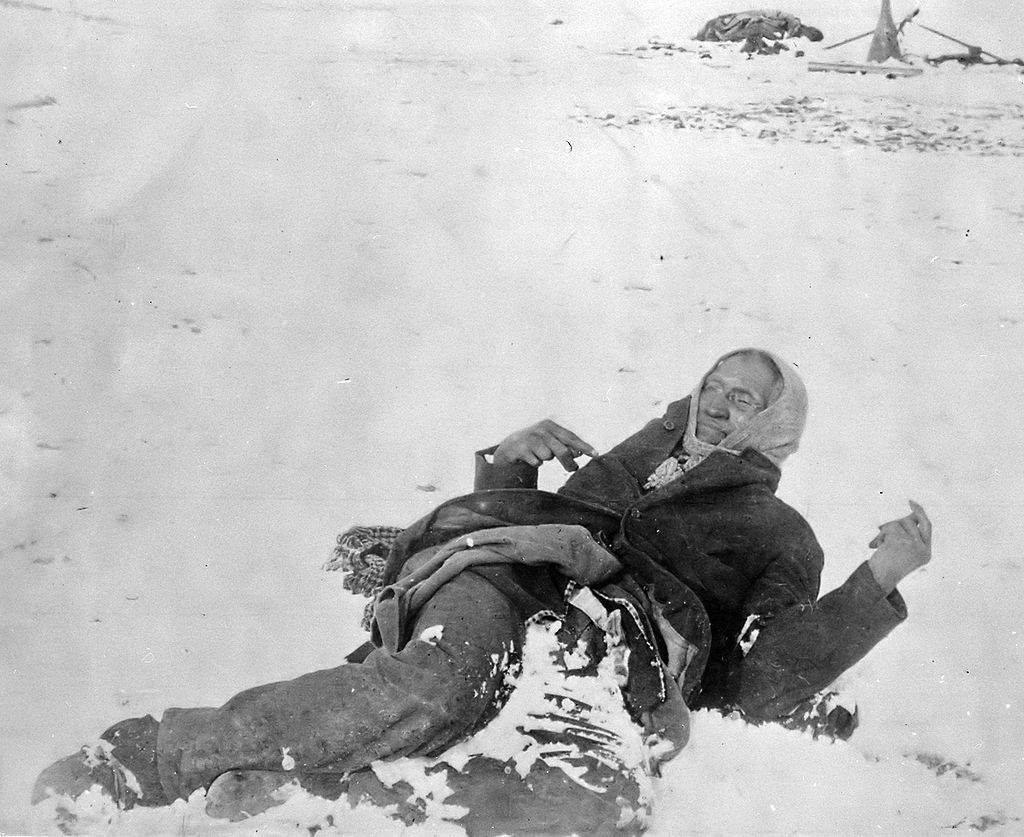
I would like to that the time, dedication, and interests of my students who made this chapter more interesting with their look into the history of First Peoples: Andriana Govea, Ashley Diaz, Keyli Cartajena, Manuel Morin, Jamie Villa, Andrea Robelo, Christian Sarmiento, Ketucua Terell, Jarren Wright, Tierra Crumb, Akilah Davis, Nancy Garcia, Anh Hua, Chandrawati Khadka, and Jacob Lenfield.
As with the other chapters, I have no doubt that this chapter contains inaccuracies. Please point them out to me so that I may make this chapter better. I am looking for contributors so if you are interested in adding anything at all, please contact me at james.rossnazzal@hccs.edu.
- Jim Heitmeyer, Restless Winds: A Different Time, Lulu, 2010. Ch. 2, p. 7 ↵
- http://chnm.gmu.edu/exploring/pre_18thcentury/creationstories/pop_sioux.html ↵
- http://navajolegends.org/navajo-creation-story/ ↵
- https://www.sciencedaily.com/releases/2004/11/041118104010.htm ↵
- https://phys.org/news/2017-01-humans-north-america-years-earlier.html ↵
- http://historyofmassachusetts.org/plymouth-colony-religion/ ↵
- https://www.monticello.org/slavery-at-monticello/life-monticello-plantation/treatment ↵
- http://www.fao.org/giahs/giahsaroundtheworld/designated-sites/latin-america-and-the-caribbean/chinampa-agriculture-in-the-world-natural-and-cultural-heritage-zone-in-xochimilco-tlahuac-and-milpa-alta/en/ ↵
- https://www.usmint.gov/coins/coin-medal-programs/native-american-dollar-coins/2009-three-sisters-agriculture ↵
- http://www.saa.org/Portals/0/SAA/publications/SAAbulletin/11-4.pdf ↵
- http://www.ancientscripts.com/epiolmec.html ↵
- Researched and written by my student Andriana Govea in the Spring semester of 2020. ↵
- Susan Stebbins. “Native Peoples of North America.” (New York: Open SUNY Textbooks, 2013), 68 knightscholar.geneseo.edu/oer-ost/22. ↵
- Susan Stebbins. “Native Peoples of North America.” (New York: Open SUNY Textbooks, 2013), 65 knightscholar.geneseo.edu/oer-ost/22. ↵
- Portland State University. “Iroquois Woman.” Iroquois Woman, Oct. 2001, web.pdx.edu/~caskeym/iroquois_web/html/iroquoiswoman.htm. ↵
- Ibid ↵
- Susan Stebbins. “Native Peoples of North America.” (New York: Open SUNY Textbooks, 2013), 97 knightscholar.geneseo.edu/oer-ost/22. ↵
- Roseanne Freese, Maire NiEoin MacRuairi, and Robert Ervin, “History of American Women,” Go to History of American Women., http://www.womenhistoryblog.com/2008/05/iroquois-women.html) (Last accessed January 30, 2020) ↵
- Ibid ↵
- Ibid ↵
- Ibid ↵
- “Haudenosaunee Women and Equality.” Oneida Indian Nation, 24 Jan. 2017, www.oneidaindiannation.com/haudenosaunee-women-and-equality/. ↵
- Pesantubbee, Michelene. "American Patriot or Cherokee Nationalist?" in American Indian Quarterly. Spring 2014, Vol. 38 Issue 2, p177-206. Found by my student Jamie Villa, Spring 2020 ↵
- Ibid ↵
- Ibid ↵
- Spring 2020 student ↵
- Dr. Susan Stebbins and Suny Potsdam, Native Peoples of North America, The State of New York Open Textbooks, 2013, ( page 62) February 5, 2020 ↵
- Ibid., p. 64 ↵
- Ibid., p. 65 ↵
- Craig Thompson, Gender Representation in Two Clackamas Myths: Studies in American Indian Literatures (University of Nebraska Press, 1991), 19. ↵
- Chinook Jargon: Oceanic Linguistics Special Publication (University of Hawai’i Press, 1975), 712. ↵
- Ibid., 712 ↵
- Rena V. Grant, Chinook Jargon: International Journal of American Linguistics (The University of Chicago Press, 1945), 226. ↵
- Chinook Jargon, 712 ↵
- Ibid., 712. ↵
- Henry Zenk, Dr. Mckay’s Chinook Address, May 11,1892: A Commemoration in Chinook Jargon of the First Columbia River Centennial (Seattle: William L. Lang and Robert Carriker, 1999). ↵
- Grant, Chinook Jargon: IJAL, 228 ↵
- Ibid., 229 ↵
- Chinook Jargon Dates Back to Early Part of 18th Century (Ellensburg Daily Record, 1921) ↵
- Stephen Harrigan. Big Wonderful Thing. A History of Texas. University of Texas Press, 2019. pp15. ↵
- Ibid. ↵
- Researched and written by Manuel Morin, an on-campus student who had to move online due to COVID-19 in the Spring semester of 2020. ↵
- Gibson, Arrell Morgan, The Kickapoos: Lords of the Middle Border (Norman, OK 1999) 4 ↵
- Lanier, Wendy Hinote, The Kickapoo (Atlanta, GA 2016) 17-18 ↵
- Nunley, Mary Christopher, Assistant Professor of Anthropology and American Indian Studies, Encyclopedia of World Cultures https://www.encyclopedia.com/history/united-states-and-canada/north-american-indigenous-peoples/kickapoo Last accessed 20200201 ↵
- Zeilinger, Ron, Native American Culture, https://www.stjo.org/native-american-culture/native-american-beliefs/four-directions/ Last accessed 20200201 ↵
- Grim, John A., Professor of Religion at Yale, Encyclopedia of Religion https://www.encyclopedia.com/environment/encyclopedias-almanacs-transcripts-and-maps/north-american-indians-indians-northeast-woodlands Last accessed 20200201 ↵
- Nunley, Mary Christopher, Assistant Professor of Anthropology and American Indian Studies, Encyclopedia of World Cultures https://www.encyclopedia.com/history/united-states-and-canada/north-american-indigenous-peoples/kickapoo Last accessed 20200201 ↵
- Grim, John A. Professor of Religion at Yale, Encyclopedia of Religion https://www.encyclopedia.com/environment/encyclopedias-almanacs-transcripts-and-maps/north-american-indians-indians-northeast-woodlands ↵
- Redish, Laura and Lewis, Orrin "Miccosukee Indian fact sheet”. (n.d). (1998) Updated 2020. Accessed September 10, 2021. www.bigorrin.org/miccosukee_kids.htm ↵
- Bowne, E. Eric “Green Corn Ceremony” (May 28, 2008) updated January 31, 2016. Accessed September 4, 2021 Green Corn Ceremony | Encyclopedia of Alabama ↵
- DBpedia. “About: Mikasuki language” August 4, 2021. Accessed September 4, 2021 https://dbpedia.org/page/Mikasuki_language ↵
- Seminoles and Miccosukees." Worldmark Encyclopedia of Cultures and Daily Life. . Encyclopedia.com. (August 16, 2021). Accessed September 10, 2021 www.encyclopedia.com/humanities/encyclopedias-almanacs-transcripts-and-maps/seminoles-and-miccosukees ↵
- Braund, Kathryn. “Creek War of 1813-14.” Encyclopedia Of Alabama. Accessed September 10, 2021. http://encyclopediaofalabama.org/article/h-1820 ↵
- Ian Berry. USA. Florida. The Everglades. Near the Miccosukee Indian Reservation. An Alligator Swims Quietly around in the Cypress Swamp.(JSTOR) Accessed September 12, 2021. https://jstor.org/stable/community.9852281* ↵


